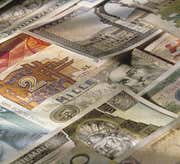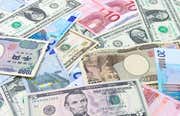|

|
Theoretically, a stock's P/E ratio tells us how much investors are willing to pay per dollar of earnings for a given company. For this reason it's also often referred to as the multiple of a stock. In other words, a P/E ratio of 20 suggests that investors in the stock are willing to pay $20 for every $1 of earnings that the company generates over a year. However, this is a simplistic way of viewing the P/E because it fails to take into account the company's growth prospects.
Although the EPS figure in the trailing P/E is usually based on earnings from the last four quarters, the P/E is more than a measure of a company's past performance. It also takes into account market expectations for a company's growth. This is because stock prices reflect what investors think a company will be worth in the future based on future cash flows and profits. One can argue then that growth is already accounted for in the current stock price. As a result, a more sophisticated way of interpreting the P/E ratio is as a reflection of the market's optimism concerning a company's growth prospects. When a company has a P/E higher than the market or its industry average, it could imply that the market is expecting good things over the next few months or years. Still, a company with a high P/E ratio will eventually have to live up to those high expectations by substantially posting stellar earnings, or the stock price will need to drop to bring the P/E back in line with reality.
A good example is Microsoft (MSFT). Several years ago, when the tech giant was growing rapidly and expanding into new markets, its P/E ratio was over 100. That meant that investors valued every $1 of annual earnings as $100 in the price of its shares. Today, Microsoft is one of the largest companies in the world, and is no longer considered a growth company. Its revenues and earnings capacity simply can't maintain the same growth as before and expectations have been moderated. As a result, its P/E had dropped to around 30 in 2017. This reduction in the P/E ratio is a common occurrence as high-growth startups solidify their reputations and turn into more stable blue chips. This doesn’t mean that Microsoft was overvalued in the past and is undervalued now. The P/E must always be considered relative to the company’s position in its life cycle and relative to its peers in the same industry and to the market as a whole. For example, newer companies with high growth prospects generally command very high P/E’s since their current earnings may be very small as they spend money to grow – but can become quite profitable in the future. For similar reasons, in general companies in the biotech and technology sectors have carried higher than average P/E’s.
Cheap or Expensive
The P/E ratio is a much better indicator of the value of a stock than the market price alone, since it allows investors to make a better apples to apples comparison. For example, all things being equal, a $10 stock with a P/E of 80 is much more "expensive" than a $100 stock with a P/E of 15. That being said, there are limits to this form of analysis – it would be naïve to simply compare the P/E’s of two different companies to determine which is a better value without considering other factors. Two cardinal considerations are:
1. Company growth rates - How fast has the company been growing in the past, and are these rates expected to increase, or at least continue, in the future? Something isn't right if a company has only grown at 5% per year in the past and still commands a very high P/E. If projected growth rates don't justify the P/E, then a stock might be rightly overpriced. In this situation, you can calculate the “correct” P/E using projected EPS, and potentially sell short those shares until the stock price falls to the level that corresponds with the correct P/E.
2. Industry or Market Sector - It is most useful to compare companies if they are in the same industry. For example, utilities typically have low multiples because they are low growth, stable industries. In contrast, the technology industry is characterized by the potential for exponential growth rates and constant change. Comparing a tech company to a utility is useless. You should only compare high-growth companies to others in the same industry, or to the industry average. Comparing a P/E to the overall market is also useful to see if the P/E of a particular stock or industry segment is keeping up with broader trends.
P/E Ratio: Problems With The P/E
-
 Investing
InvestingCan Investors Trust The P/E Ratio?
The P/E ratio is one of the most popular stock market ratios, but it has some serious flaws that investors should know about. -
 Trading
TradingValue-Priced Stocks to Watch in 2016 (AMBC, VIPS)
In terms of P/E and Forward P/E these stocks are trading at low valuations. Watch these technical price levels for buying opportunities in 2016. -
 Investing
InvestingUnderstanding The P/E Ratio
Learn what the price/earnings ratio really means and how you should use it to value companies. -
 Investing
InvestingWhat Lies Ahead for Apple's P/E ratio
Recently, Apple's P/E multiple has come down to levels equal to the S&P 500. What does the future hold for the tech giant's P/E ratio? -
 Investing
InvestingStocks With Bubbles That Could Burst in 2016
These are some of the over-valued stocks based on P/E and Forward P/E ratios. Will the bubbles burst in 2016? -
 Investing
InvestingThe Netflix P/E Ratio: What You Need To Know
We show you how to compute and analyze the P/E ratio for Netflix. -
 Investing
InvestingThe average price-to-earnings ratio in the retail sector
Find out about the retail sector's average price-to-earnings ratio, or P/E ratio, and average P/E for companies in the seven different categories of retail.


